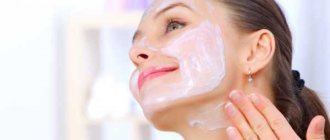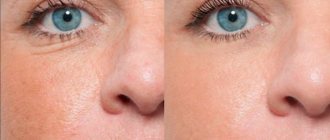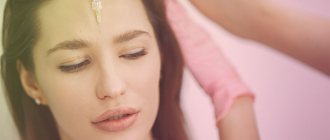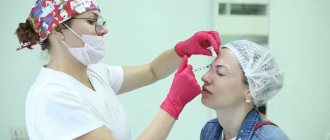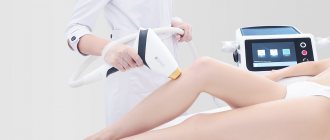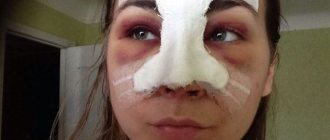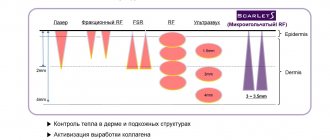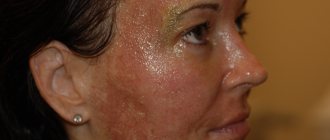Many modern women prefer to combine peeling and biorevitalization, since together these procedures have a pronounced rejuvenating effect. This combination is beneficial for skin of any age, but most often cosmetologists recommend it to patients after 35 years of age, because skin aging processes accelerate from this age.
In order not to cause harm to the skin instead of benefit, you should know how long after biorevitalization you can go for hair removal.
Photorejuvenation and Botox
Photorejuvenation and Botox do not compete with each other and are not mutually exclusive procedures. But it is worth considering some factors:
- Botox and phototherapy are not done simultaneously in the same area. This may lead to the ineffectiveness of botulinum therapy.
- If you have already received Botox, Dysport or Xeomin, then you can carry out the phototherapy procedure no earlier than 2-3 weeks after botulinum therapy.
- When planning a combination of techniques such as photorejuvenation and botulinum therapy, it is better to perform phototherapy, and after 2-3 weeks consolidate the result with botulinum toxin injections.
Also, in some cases, it is recommended to leave an interval of 3-4 months between phototherapy and Botox. Because a course of photorejuvenation has an increasing effect and, as a result, botulinum therapy may not be necessary. Or a significantly smaller amount of the drug will be required.
What it is?
- Biorevitalization is a cosmetic procedure aimed at rejuvenating the skin through the targeted administration of hyaluronic acid-based compounds. Saturation of the skin with vitamin complexes is carried out using gel injections or laser.
- Hyaluronic acid is responsible for water retention; its decrease leads to skin aging and breakdown of elastin and collagen molecules.
The balance of endogenous hyaluronic acid decreases by 6% every 10 years.
Biorevitalization allows you to compensate for the loss of hyaluronic acid, restore youth to the skin and stimulate the production of your own hyaluronic acid.
The drug is pumped locally into areas requiring rejuvenation, for example:
- forehead;
- nasolabial folds;
- neck, etc.
Active substances, entering the deep layers of the skin as a result of targeted action, stimulate the production of elastin and collagen.
In addition, formulations based on hyaluronic acid:
- moisturize the skin;
- improve its appearance;
- stop aging;
- smooth out wrinkles.
Photorejuvenation and peeling
Peeling is one of the universal and favorite procedures of most of our patients. The great news is that photorejuvenation and peeling are not only combined with each other, but they can even be alternated.
Let's start with the fact that 2 weeks before phototherapy it is even recommended to carry out superficial (this is important) peeling. After removing the keratinized layer of cells, the result of phototherapy will be much brighter.
Superficial peels can also be performed between phototherapy sessions. This alternation will enhance the regeneration process and speed up the achievement of the desired result.
But medium and deep peelings between procedures are not recommended. Complete restoration of the skin after peeling is necessary, and this can take from a month to six months.
What happens to the skin if you combine plasma lifting with peeling?
Blood plasma is 92% water. The remaining 8% consists of biologically active components - hormones of the endocrine glands, vitamins, microelements, and growth factors. Once in the skin, the plasma moisturizes it and restores the moisture deficit that arose as a result of the aggressive effects of chemicals during peeling.
Plasma biocomponents have a positive effect on the course of biochemical processes and accelerate purification. At the injection site, they create a hormonal background that matches young skin. Lactic and pyruvic acids in plasma have a powerful brightening effect, so the result of plasmolifting is a reduction in age spots and radiant skin with a pleasant pearlescent tint.
What is the essence of plasma lifting? How is blood plasma for injection obtained? What is the secret to the effectiveness of the procedure? Answers - from a practicing doctor:
Photorejuvenation and fillers
Contour plastic surgery using fillers is not a contraindication for phototherapy. But it is not recommended to carry out the photorejuvenation procedure earlier than 1-2 months after contouring.
The fact is that pulsed light can affect the rate of decomposition of hyaluronic acid. After 6-8 weeks, phototherapy will not affect the filler in any way, but will only improve the result.
Photorejuvenation and fillers can perfectly complement each other in reverse dynamics. Initially, a course of 5-6 sessions of photorejuvenation is carried out, and then contour plastic surgery is performed.
For the most impatient patients, it is possible to correct the required areas with fillers 2-3 weeks after phototherapy. immediately after the inflammation subsides. But, just as in the case of Botox, if you are patient and wait 5-6 months, you may not need contouring at all.
Let's understand the definitions and effects
Peeling and biorevitalization are completely different procedures in terms of their effects. But both have a positive effect on the skin. With their help, you can solve many problems caused by both the deplorable state of the epidermis, provoked by external negative factors, and the processes of chronological aging of the skin.
Both procedures help stimulate epidermal restoration processes at the cellular level. They encourage our body to produce its own substances that are responsible for the healthy appearance of the skin.
Read: reviews of Aquashine biorevitalization with before and after photos.
Collagen and elastin, unfortunately, are produced slowly after 30 years and such quantities are not enough to ensure normal turgor. Wrinkles and grooves begin to appear, the skin becomes dull, becomes grayish, and the oval of the face blurs.
Many can say that this state of affairs is inevitable and anti-aging cosmetics, foundations, and concealers will help stop these processes or hide them. But how long will it last and won’t all these tricks spoil the overall picture? After all, high-quality anti-aging drugs are quite expensive, and low-quality cosmetics can only worsen the situation.
Nobody said that you don’t need to use skincare products every day - this is an axiom for every woman who tries to take care of her appearance. But modern cosmetology offers innovative methods that help make care even more effective.
What is biorevitalization?
Biorevitalization is the saturation of the deep layers of the epidermis and dermis with hyaluronic acid. Transportation of acid preparations with vitamin complexes is carried out by injecting a gel or introducing it using a laser.
Hyaluronic acid is a component of the intercellular fluid of lymph, blood and skin. It does not cause rejection, takes root well and has a positive effect on all processes occurring in the epidermis and dermis:
- fluid retention, deep hydration;
- stimulation of collagen and elastin production;
- normalization of metabolic processes;
- saturating the skin with vitamins, minerals and other components necessary for normal functioning.
To achieve a stable, long-lasting effect, it is necessary to undergo a course of procedures. Their number will be determined by a specialist who will assess the condition of the skin, the client’s age, the presence of indications and contraindications.
What is peeling?
Peeling, or esfoliation, unlike biorevitalization, does not involve the introduction of any substances into the skin. This is the removal of dead epithelial cells in order to expose young and healthy ones, which triggers natural metabolic processes.
The epidermis is a five-layer structure. These layers are constantly renewed, the dead layers are peeled off. But with age, metabolic processes slow down and the separation of the “spent” layer is poor. Sometimes dead cells remain on the surface for a long time, which interferes with cellular respiration and the penetration of useful substances into the skin. For the normal functioning of the epidermis and dermis, they need to be removed in time and stimulate natural metabolic processes.
Beauty salons and clinics use acidic preparations for procedures. Their concentration is quite high, which does not allow the use of such products at home. The manipulation must be performed by a highly qualified specialist to eliminate the risk of burns and significant damage to the skin.
But you can make a scrub at home that will help get rid of dead cells more gently, but with regular use no less thoroughly. To prepare such products, sour fruits, oatmeal, semolina, coffee, and essential cosmetic oils are used.
Modern cosmetology dictates new rules according to which it is possible to combine both procedures, which guarantees an enhanced rejuvenation effect. So how long after peeling can biorevitalization be done and is this combination recommended for everyone?
Photorejuvenation and cosmetic care
Here are some procedures that not only can be combined, but are also necessary: photorejuvenation and cosmetic care!
Cosmetic procedures can be performed before, after and during a course of phototherapy. The only limitation is the need to maintain an interval of 2-3 days after the phototherapy session. This is necessary so as not to provoke swelling or inflammation.
Moisturizing, nutrition and sun protection programs are indicated after photorejuvenation. This allows you to speed up the rehabilitation process and increase the effect.
And don’t forget that although photorejuvenation can be carried out during sunny periods, after the procedure the skin needs protection from the harmful effects of ultraviolet radiation!
Is it possible to do peeling after plasma lifting?
Peeling is a basic cosmetic procedure, so other hardware and injection techniques are often recommended to be carried out after it or simultaneously with it.
Plasmolifting is an injection of autoplasma that injures the skin. To avoid redness and irritation, it is advisable not to peel after this for several days. At this time, the skin is renewed naturally, and it is enough to use only a healing cream recommended by a cosmetologist. After the skin has healed for 1-2 months, only superficial light peels can be done.
Photorejuvenation and biorevitalization
Photorejuvenation and biorevitalization are not performed at the same time, but are an excellent complement to each other.
Depending on the type and characteristics of the skin, the specialist will determine which procedure needs to be performed first.
For example, most often, owners of oily skin initially undergo phototherapy, and after 2-3 weeks biorevitalization is performed. But for those with dry skin, on the contrary, biorevitalization is primarily prescribed, and after the rehabilitation period, photorejuvenation is performed!
Contraindications
Like any other cosmetic manipulation, peeling and biorevitalization have their own contraindications.
The main ones include:
- exacerbation of diseases, infections;
- inflammation of the skin in the area of the upcoming treatment;
- disorders of neuromuscular transmission (myasthenia gravis and its syndromes, amyotrophic lateral sclerosis, etc.);
- pregnancy and lactation;
- the first 1.5 months after blepharoplasty;
- allergic reactions to injection and cleaning components;
- alcohol abuse;
- the first two weeks after taking antibiotics, anticoagulants;
- the first three months after facial surgery.
Which sequence is better to choose?
The optimal alternation of facial cleansing and biorevitalization procedures is the one that suits you personally. Each patient has his own characteristics of the body; there are no general recommendations. There is an opinion that the correct sequence of procedures should be determined after at least two consultations with an experienced cosmetologist. The specialist will not only select techniques for your specific case, but will also set the necessary time frames between each stage.
That is why you should not expect a definite answer to the question of what is better – peeling or biorevitalization. Both procedures have different effects on the skin of the face, so it is incorrect to look for their advantages and disadvantages in comparison with one another.
When preparing the material, consultation was carried out by:
Olga Kirilova (cosmetologist). A specialist with higher medical education and extensive work experience. Helped hundreds of patients cope with various skin problems. Conducts non-hardware and hardware procedures. Proficient in laser and phototherapy techniques.
Share with your friends!
Subscribe to our Yandex.Zen channel or Yandex.Messenger
Sequence of procedures
The main question that clients who want to undergo facial skin treatment and rejuvenation ask at an appointment with a cosmetologist is the choice of the sequence of actions.
What is the best course of action: undergo peeling and then agree to hyaluronic acid injections or change the order of procedures. There is no definite answer to this question, since the specialist will make a decision on an individual basis, based on the characteristics of your body and skin condition, as well as other factors (age, the presence of certain diseases, taking certain medications, etc.).
Both procedures differ radically in technology, type of effect on the skin and materials used during the process. This is also necessarily taken into account when choosing the sequence and tactics of action.
Why is this stage critical? It all depends on which skin cleansing technology is chosen: retinoic (“yellow”) or chemical peeling. The second option is more traumatic , and after it is carried out, the facial skin tissues remain swollen for a long time. If you inject hyaluronic acid within the permitted period after chemical peeling, the regeneration process will be accelerated, due to which the swelling will go away a little faster.
The effect is explained by the peculiarities of the action of hyaluronic acid, which adsorbs excess liquid remaining in the epidermal cells after chemical cleansing. However, biorevitalization cannot be carried out immediately: a certain time interval must be maintained.
Retinoic peeling has a gentle effect on the skin, so biorevitalization after it is carried out in a shorter time. Already on the third day, the balance of vitamin A in the treated skin is restored enough to create a reliable effect against aggressive external factors.
Peeling before biorevitalization
If you are advised to cleanse your facial skin before administering hyaluronate injections, please note that one of the effects achieved will be a reduction in the period of regeneration of the epidermis after the use of aggressive acids.
The selected procedure diagram will look like this:
- To begin with, the cosmetologist will perform approximately two deep cleanses with glycol at intervals of 7 to 10 days. Thanks to this procedure, the facial skin will be exfoliated from dead cells, and active collagen synthesis will begin in its deep layers;
- Then intermediate injections of hyaluronate are carried out after 4 - 5 days;
- After another 5–6 days, the patient undergoes two peeling procedures again with an interval of a week;
- Having completed all these steps, it again undergoes final biorevitalization 5 days after the last peeling.
With this scheme, a complex effect is achieved, namely: the skin recovery period is shortened, the patient practically does not abandon the usual rhythm of life, and the result of the procedure is noticeable to the naked eye after 15 days.
Biorevitalization before peeling
The chosen method of facial rejuvenation, in which peeling is carried out step by step after biorevitalization, also has its own characteristics. They include a special sequence, number and order of manipulations:
- Hyaluronic acid injections are carried out in three doses, with an interval of 15 days between each procedure;
- After this stage, the patient undergoes retinoic peeling. Recovery after cleansing and how effectively the process of facial skin restoration proceeds largely depends on the conscientious implementation of medical recommendations (we’ll talk about them below), which are mandatory during the rehabilitation period.
It is believed that biorevitalization carried out before peeling will facilitate the skin regeneration process and reduce the risk of side effects and complications.
Types of yellow peeling
There are two types of yellow facial peeling:
- classic - retinoic, it uses synthetic acid;
- soft - retinol, a natural compound is used.
Soft peeling cleanses the skin more gently, but the result does not come very quickly compared to the classic procedure. But you can do it as often as you want. In addition, this type does not require pre-preparing the skin.
Recommended articles on the topic:
- Ultrasonic facial peeling is a pleasant and beneficial procedure for your skin
- Redermalization of the skin: all the pros and cons
- Almond peeling for the face: features of the procedure
Retinoic exfoliation is done no more than two to three times a year. The course includes three sessions with a two-week break between them.
Classic peeling can be:
- one-day (after the manipulations, the patient himself removes the mask after 12 hours);
- two-day (in this case, on the first day, the mixture is applied to the face several times, thoroughly cleansing the skin after the previous application; two hours after the procedure, the patient himself removes the last mask; the next day the same manipulations are carried out).
The result of using yellow peeling
The main effect of retinoic acid peeling is noticeable skin rejuvenation. Acne marks become invisible and pigment spots disappear. The pores are cleansed and excess sebum is removed from them. Dead cells are eliminated.
In addition to retinoic acid, the peeling contains other acids:
- kojeva, which exfoliates dead cells (derived from certain mushrooms);
- azelaic, or carbonic, helps eliminate age spots, reduces the activity of the sebaceous glands;
- phytic acid, which has anti-inflammatory properties, helps renew skin cells (it is obtained from the seeds of cereals, oilseeds and legumes);
- ascorbic acid (vitamin C), improves the relief, color and turgor of the skin, prevents aging.
After retinoic cleansing, the skin becomes healthier, regeneration processes are launched, good color returns, and fine wrinkles disappear. The delivery of nutrients to all layers is improved. The face overall looks more youthful.
Is it possible to do it together?
It is strictly forbidden to perform both procedures simultaneously, as they are characterized by a high degree of trauma. Injections of hyalurnic acid after peeling can only be done after the recovery period has been completed, otherwise the risk of complications increases.
Why can our articles be trusted?
We make health information clear, accessible and relevant.
- All articles are checked by practicing doctors.
- We take scientific literature and the latest research as a basis.
- We publish detailed articles that answer all questions.
After what period of time the procedures are allowed to be carried out, the doctor determines. At the same time, he must take into account the characteristics of the epidermis of each woman. As a rule, if biorevitalization is done after chemical peeling, then at least 14 days must pass. When using retinoic acid, the interval is 4-5 days.
